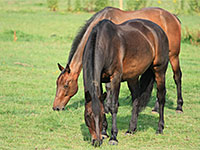Contacts:
Lloyd Veterinary Medical Center
(515) 294-1500
May 2, 2015

- EHV-1 can cause respiratory disease (rhinopneumonitis), abortion and neurologic disease (herpes myeloencephalopathy / EHM)
- Equine herpes virus-1 (EHV-1) generally affects older horses (> 20 years)
- Signs of EHM: Pelvic limb ataxia and urine dribbling predominate; cranial nerve deficits, generally of cranial nerves VII-XII, are occasionally detected. Pyrexia (fever) may precede neurologic signs; horses may have a normal body temperature at onset of signs of EHM.
- Pathogenesis: Primary infection occurs in the epithelium of the upper respiratory tract with viral shedding for up to 2 weeks (4 weeks or more in EHM horses). Cell to cell spread leads to infection of respiratory tract lymph nodes followed by a cell-associated viremia (virus contained within circulating white blood cells) that allows virus to be transported to endothelial cells which line small vessels; the virus has a predilection for the small vessels serving the CNS (brain stem / caudal cord) or pregnant uterus.
- For practical purposes, it should be assumed that all adult horses are latently infected with EHV-1
- Multiple strain variants exist in horses; horses can be co-infected with different strains.
- The DNA polymerase of EHV-1 is the enzyme that synthesizes DNA molecules from nucleotide building blocks; it is essential for viral replication. The enzyme is encoded by a gene and sequence analysis of the EHV-1 DNA polymerase has revealed a single position in the genetic code that impacts the efficiency of viral replication. This position in the polymerase is 752. Viral polymerases containing an aspartic acid, denoted by the letter “D” at position 752 (D752), replicate extremely efficiently to high titer. Viral polymerases containing an asparagine -“N”- at position 752 (N752) replicate less efficiently and to lower titers. Importantly, however, both strain variants can cause neurologic disease.
- N752 strains have been causally associated with >95% of abortion outbreaks.
- Is there a single strain of EHV-1 that causes EHM? No – variants carrying the D752 marker are associated with the most neurological disease outbreaks. However, 15-25% of neurologic disease outbreaks are associated with N752 containing strains. The association of D752 with a higher percentage of EHM outbreaks has led to usage of D752 strains as being “neuropathogenic”. This terminology can be misleading as N752 strains also cause EHM. Biosecurity measures, including quarantine, need to be implemented for both N752 and D752 strains.
- Testing: Molecular techniques are favored due to the more immediate turn-around time for results compared with serologic techniques. Uncoagulated blood (e.g., EDTA purple top tube) is used for testing for virus in white blood cells and nasal swabs (Dacron, not cotton tipped) are obtained to test for nasal shedding. Quantitative PCR, often referred to as “real-time” or “Q”-PCR, can provide information regarding viral load and thereby provide insight into shedding, with increased shedding associated with higher viral load. EDTA samples can be used for virus isolation whereas paired serum (red top tube) samples collected 2-3 weeks apart can be used for virus neutralization assays or ELISA. Absent fever and clinical signs, diagnostic testing is not recommended.
- The goal of vaccination is generation of protective mucosal antibody and robust cytotoxic T-cell responses (CTLs). EHV-1 is a difficult adversary, however, as the virus can interfere with immune regulation and persist and replicate. Immunoprotective responses are short-lived, too. Notwithstanding, vaccination can reduce shedding and could be helpful in the face of an outbreak. In general, modified live products elicit a more robust cell-mediated immune response compared to inactivated (killed) products. However, data demonstrating a clear advantage for use of the modified live product (Rhinomune, Boehringer Ingelheim) over the inactivated products are lacking.
- Outbreak management and biosecurity – rapid diagnosis (PCR), prevention of spread and isolation and care for clinical cases are the first steps. AAEP guidelines suggest a 28 day quarantine period or a two week quarantine coupled with testing of nasal samples. In this approach, quarantine would extend another two weeks upon detection of nasal shedding or development of clinical signs among other horses.
Resources for additional information:
Equine Herpesvirus-1 Consensus Statement,
D.P. Lunn et al., J. Vet. Intern. Med. 2009; 23:450-461
Vaccination
Equine Herpesvirus-1 Consensus Statement,
D.P. Lunn et al., J. Vet. Intern. Med. 2009; 23:450-461
Vaccination
